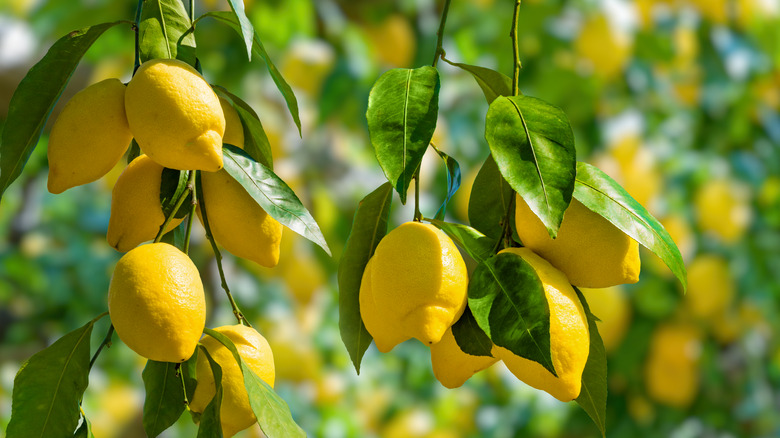The Simple Answer To Why Your Lemon Tree Leaves Are Turning Yellow
You might initially be excited to see a glimpse of yellow amongst your lemon tree's leaves, thinking that the tree is finally bearing fruit. But that excitement can quickly turn to dread when a closer inspection reveals yellowing leaves instead. It can be anxiety-inducing to see your lemon tree on the decline, especially if you've taken the time to grow it from seed. If you're eager to determine why your lemon tree is struggling, but don't know where to start, it might benefit you to assess the conditions of your lemon tree's soil and the micronutrients it may be lacking.
Many gardeners know how to tell if their garden soil is lacking in nitrogen and how to balance its ratio with carbon in their own DIY compost, but there are a few lesser-known micronutrients that can affect your plants' long-term nutrition, such as zinc, manganese, and iron. Iron chlorosis occurs when plant foliage turns yellow due to a lack of iron available in the soil, and it may be why your lemon tree's leaves are turning yellow. In particular, if you aren't growing your citrus tree indoors, and your area's soil tends to be more alkaline in pH, iron deficiency is likely the source of the yellowing leaves.
Signs of iron deficiency in lemon trees
Not all chlorosis is caused by iron deficiency, but there are few telltale signs for when it is. If your lemon tree's leaves are yellowing, but the small veins along the leaves remain dark green, lack of iron is to blame. Over time, as the deficiency becomes more severe, leaves will drop from the tree, the new growth will be smaller and lighter yellow or ivory in color, and the branches of your lemon tree will die back. Dieback caused by iron deficiency will be most noticeable on the tops and sides of your lemon tree.
Flooded roots, poor drainage, and the presence of heavy metals like copper in the soil can lead to iron deficiency, so it may be wise to keep an eye out for conditions such as these well before your lemon tree shows signs of distress. Measuring the pH of your soil can be a crucial predictor for iron deficiency: Due to a higher presence of bicarbonates and the low solubility of iron in alkaline soils, the likelihood of iron deficiency increases in calcareous soils with a pH between 7.4 and 8.5. If you're not certain that iron is the cause of your lemon tree's yellowing leaves, testing soil pH and looking for root damage caused by excess water accumulation may further illuminate whether iron levels are indeed the issue.
How to fix iron deficiency in your lemon tree
Iron deficiency can be difficult to diagnose and correct. Even with abundant iron levels in the soil, iron absorption can be affected by the factors mentioned above, namely irrigation and soil alkalinity. The best fix for iron deficiency is a preventative approach: Ensure that your lemon tree is planted in slightly acidic, well-draining soil, and water and fertilize the plant regularly.
But if your lemon tree is already showing signs of iron deficiency, don't fear. You can amend micronutrient deficiencies using foliar sprays of the appropriate nutrient, though there is some evidence that foliar sprays are less effective than other methods of correcting iron deficiency specifically. The best way to fix iron deficiency is adding iron chelates directly to the soil; chelated iron is a form of iron that is more absorbable by plants in alkaline or leached soils. Improving and closely monitoring drainage and irrigation patterns can also help fix iron deficiency longer-term, particularly if you are in an area with alkaline soils.


